15mm screw thread caps, septa, and vials are designed especially for use with Agilent's and other rotating or robotic arm samplers 12ml, 18.4X65mm vials are manufactured of Clear
Type 1 Class A or Amber, Type 1 Class B borosilicate glass and include a write-in patch for sample identification
Caps are made of high quality polyproylene to exact manufacturing tolerances and lined in a controlled manufacturing environment
black pp caps with hole or not
Our septa use only the highest quality materials to ensure proper function and can be pre-slit to ease needle penetration
Designed for single injection and/or short sample cycles, particularly for LC applications
Absence of elastomer layer reduces potential for contamination
+
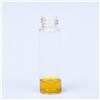 |
 |
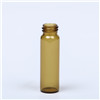 |
|
| Part No. | V1817 | V1827 | V1837 |
| Description | 12ml screw-thread vial, clear 18.4*65mm USP 1 |
12ml screw-thread vial, clear with write on patch 18.4*65mm USP 1 |
12ml screw-thread vial, amber 18.4*65mm USP 1 |
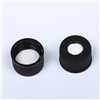 |
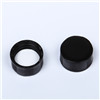 |
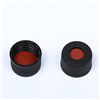 |
|
| Part No. | SC152151 | SC152152 | SC155151 |
| Description | Nature PTFE/nature Silicone septa , 15mm black screw polypropylene cap, 8.5mm centre hole | Nature PTFE/nature Silicone septa , 15mm black screw polypropylene cap, closed-top | Clear FEP/red Rubber septa, 15mm black screw polypropylene cap, 8.5mm centre hole |
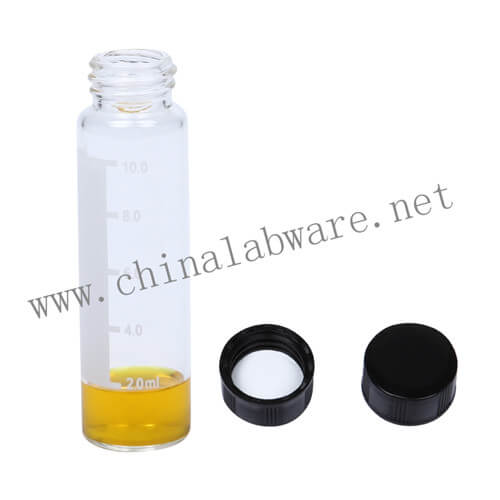

|
8ml screw HPLC vials, Caps and Septa, ND15 100pcs/pack |
|
|
S152 |
Nature PTFE/nature Silicone septa Φ15*1.5mm temperature resistant -60℃-200℃ |
|
S155 |
Clear FEP/red Rubber septa Φ15*1.5mm temperature resistant -60℃-200℃ |
| SC152151 |
Nature PTFE/nature Silicone septa , 15mm black screw polypropylene cap, 8.5mm centre hole |
|
SC155151 |
Clear FEP/red Rubber septa, 15mm black screw polypropylene cap, 8.5mm centre hole |
|
SC152152 |
Nature PTFE/nature Silicone septa , 15mm black screw polypropylene cap, closed-top |
|
SC155152 |
Clear FEP/red Rubber septa, 15mm black screw polypropylene cap, closed-top |
|
V1817 |
12ml screw-thread vial, clear 18.4*65mm USP 1 |
|
V1827 |
12ml screw-thread vial, clear with write on patch 18.4*65mm USP 1 |
| V1837 | 12ml screw-thread vial, amber 18.4*65mm USP 1 |
| V1847 | 12ml screw-thread vial, amber with write on patch 18.4*65mm USP 1 |

+
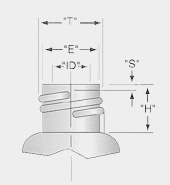
+
The workers clean the tubing with cloth
The workers plug the tubing into machine for making vials
The vials are transferred to QC for Physical Test
The workers put the tested vials into one big package (500-800pcs/pack)
The workers get the vials from big package and put the vials into one special tray.
Put the tray with vials into the Water injection machine
The vials in tray will be transferred to next step for Ultrasonic oscillations.
The vials in tray will be transferred to Jilt water machine.
The vials in tray will be transferred to Infrared drying case.
The workers will collect the vials after vials are dry.
The vials in tray will be transferred to next step for Ultrasonic oscillations.
The workers will check all the vials inclouding the bottom neck ,bottom ,inerts.
The workers will pack 100pieces vials into one package.
The workers will send the package to sealing machine for packing.
+
Autosampler Compatibility
Not all autosamplers are alike. Some utilize robotic arms to pick up a sample vial; some use tray rotation while others move the sampling needle to the respective vial coordinates. The dimensions of autosampler vials vary. Most autosamplers are equipped with trays that use 12x32mm vial configurations but some like the Waters Wisp require a 15x45mm configuration. Consult your autosampler’s operating manual or manufacturer to determine the vial dimensions required.
Sample Volume
The amount of sample available for analysis is important in choosing the appropriate vial. If only a limited volume of sample is available, you will have to choose between using an insert for your regular autosampler vial, a microvial or a high recovery vial.
Note: Most 12x32 mm autosampler vials hold between 1.5mL to 2.0mL of liquid, depending on where the manufacture measures the vial full. The dimensions for 12x32mm vials are standard between manufacturers but the length of the neck and width/shape of the vial shoulder may vary. 12x32mm microvials have the same outer dimensions but the inside of the vial may be tapered to reduce volume or contain a fused insert. 12x32mm high recovery vials will have an internal conical bottom that allows for maximum sample recovery.
Sample Compatibility
The analyte and solvent compatibility should be considered in choosing vials and accessories. For example, amber glass is most often used for light sensitive samples while deactivated glass or plastic vials are used for compounds that are sensitive to glass or stick to the glass itself. Volatile samples require closures that reduce the risk of analyte loss due to evaporation.
Vial Composition
Several factors need to be considered when choosing laboratory glass - chemical inertness, durability, light sensitivity, storage conditions, analyte composition and especially exposure to heat/freezing temperatures. Linear Coefficient of Expansion refers to the fractional change in the length of glass per degree of change in temperature, in short, the ability of the glass to tolerate rapid thermal changes. The lower the coefficient of expansion the better the glass can handle temperature change without fracturing.Classifications for laboratory glass based on its resistance to attack from water were established by the United States Pharmacopoeia, USP.
USP Type 1, Class A, 33 Borosilicate Glass is the most inert and chemically resistant glass widely used in laboratories especially for
chromatography applications. Type I glass is composed primarily of silicone and oxygen, with trace amounts of boron and sodium. It
has the lowest leaching characteristics and a linear coefficient of expansion of 33.
USP Type 1, Class B, 51 Borosilicate Glass which is composed of silicone and oxygen, trace amounts of boron, sodium and other element is more alkaline than Class A glass but still adequate for laboratory use. All amber borosilicate glass is made of Class B unless otherwise specified and has an expansion coefficient of 51.
Silanized or deactivated glass is borosilicate glass that has undergone further deactivation by treating the surface of the glass with an organosilane. The surface becomes more hydrophobic and inert making the vial suitable for use with pH sensitive compounds, trace analyses and applications requiring long term sample storage.
USP Types II, III and NP glass are manufactured from soda lime which has less chemical resistance than borosilicate.
Polypropylene is a rigid and translucent material, which also comes in a variety of colours and has good chemical resistance for short term storage of most common laboratory chemicals. Resistance decreases over time when using aromatic and halogenated hydrocarbons.
Polypropylene vials are often used for ion chromatography because of the extremely low metal content and excellent cleanability with dilute acid followed by deionized water rinse.
Polypropylene vials limit the exposure to hazardous materials since they can be incinerated while sealed.
Polymethylpentene (TPX) is a rigid transparent material, which has a relatively high melting point with a temperature range of 0°-170°C. TPX vials can be used as alternative to opaque polypropylene vials because they provide maximum clarity. Their chemical resistance is similar to that of polypropylene vials. TPX vials should be used for applications where visual clarity is required or repetitive exposure to higher temperatures such as autoclaving. TPX vials tend to be more brittle at room temperature.
Type of Vial Finish and Closures
Autosampler vials are available in a variety of neck finishes and opening diameters. Large mouth or wide ID vials have approximately a 40% wider mouth opening than standard opening vials. The large opening reduces the risk of bent autosampler needles during sampling.
Screw thread vials and caps provide low evaporation, reusability, less hand injury during manipulation than crimp seals and require no special tools. All screw threads vials and caps
are differentiated by their thread finish as defined by the Glass Packaging Institute, GPI. For screw thread vials, a two part number is assigned. For example, 8-425 neck finish represents a vial with a diameter of 8 mm across the outside of the threads and a thread style of 425. Screw thread vials and caps are more expensive than crimp seals. Caps for screw thread vials are available with either an open hole for autosampler use and standard addition or with a solid top for sample storage. One piece polypropylene cap and
membrane are also available. These pierceable screw thread caps are designed for one time use and reduce sample preparation time as there is no cap and seal to assemble.
Crimp top vials require lacquered aluminum crimp seals which are relatively inexpensive and, when properly assembled, provide the best seal for long term storage. Crimp seals are not reusuable.
A crimping tool is required to seal caps and a decrimper or decapper is required to remove the seals. Several types of hand crimpers are available including the adjustable precision
crimpers that Chromatographic Specialties offers. Adjustable hand crimpers feature an adjustable stop on the handle to provide consistent seal tightness every time. Adjusting the hex screw inside the steel crimper jaws will also alter the amount of crimp. Achieving a good crimp is crucial because overcrimping can cause septum coring, bent needles and create a larger hole in the Teflon septum layer than a properly crimped seal. Undercrimping can result in loose seals and sample evaporation.
Hand decrimpers quickly and safely remove seals with just a single squeeze of the handle.
Decappers are similar in design to pliers and provide an inexpensive alternative to decrimpers.
Decrimpers should be used for applications involving hazardous samples because there is less chance of spillage.
Electronic crimpers and decappers are also available. Electronic units reduce hand fatigue, provide consistent crimps and are ideal for laboratories analyzing a lot of samples.
Snap seal vials are less prone to breakage during decapping because more glass is used in the neck of the vial. The snap seal neck finish is compatible with either crimp and/or snap
seals and no special tools are required to remove the cap. These vials are recommended for short term sample storage and non-volatile samples because the seal is not as secure as a crimp or screw thread seal.
Shell Vials are an economical alternative to screw thread vials for Water’s HPLC autosamplers or any other autosampler that doesn’t use a robotic arm to move the vials. Most shells vials are sold with a polyethylene cap that has a starburst design for easy needle penetration.
WHAT TO CONSIDER WHEN SELECTING THE PROPER INSERT
Dimensions of the Autosampler Vial
Choosing the incorrect size of insert for an autosampler vial can result in poor reproducibility between sample injections, damage to the autosampler needle and an inadequate seal between the septum and the vial. The dimensions listed for insert size in the catalogue refer to the outside diameter and length. Inserts with an outside diameter of 5mm are used with vials with standard mouth openings and the 6mm are used with wide mouth vials. The length of the insert should be flush with the neck of the vial to prevent the
insert from causing the septum to bulge.
Conical inserts have a tapered bottom with pulled tips and are available with or without plastics springs. The spring acts as a shock absorber during needle penetration and raises the insert above the bottom of the vial, allowing greater sample recovery.
Mandrel inserts also have a tapered bottom but the tips have been precision formed over a mandrel to give the internal tip a “V” shape that reduces the residual volume of the insert. Mandrel precision formed inserts are recommended when maximum recovery of the sample is required.
Flat bottom inserts have the largest capacity and are the most economical inserts. These inserts are cylindrical in shape with a flat bottom
Hanging inserts have either a flange top or top spring that suspends the insert correctly centered in the vial.
Step inserts with a built-in glass flange are designed specifically for step vials with a special tapered neck. The flange suspends the insert correctly centered in the vial without causing a bulge in the septum when the cap is screwed on.
Limited volume inserts are an economical solution when there is a limited amount of sample and injection is done using an autosampler.
Most autosamplers have a set depth that the injection needle can go into the vial without bottoming out. Inserts increase the sample depth within the vial even if there is a very minute volume of sample available.
Solvent Compatibility
Type I borosilicate glass inserts are most commonly used for trace analysis in chromatography.
Polypropylene inserts are less expensive than glass and are suitable for applications involving pH sensitive samples.
Insert Shape and Point Style
The style of insert chosen is dependent on the amount of sample available and the residual volume after sampling.
WHAT TO CONSIDER WHEN SELECTING SEPTA
Septa Material Advantages Chemical Resistance Applications Max Temp
PTFE Economical Excellent For single injection only 550°C
PTFE/silicone Excellent resealing Excellent until punctured Multiple injections 200°C capabilities Not suitable for chlorosilanes than moderate resistance
Pre-slit PTFE/silicone Reduces coring Excellent until punctured Multiple injections 200°C
Prevents vacuum from than moderate resistance inside the vial
PTFE/silicone/PTFE Resistant to coring Excellent Above average resealing 200°C
Autoclavable Multiple injections or applications with long periods between injections
PTFE/red rubber Economical Excellent until punctured Moderate resealabililty 110°C not recommended for holding samples for further analysis
Molded polypropylene Economical Good For single injection use only 130°C
Not resealable
Gray butyl Very economical Not suitable for chlorinated Suitable for low pressure 125°C solvents, alkanes, benzenes applications or cyclohexanes
Viton Excellent chemical resistance Average resealability 160°C
Good for chlorinated solvents
Not recommended for use with amines, pyridine, acetonitrile, DMF, DMSO, THF, dioxane,methanol, Freon 22, ethylacetate, acetone or acid anhydrides.
Septum compatibility or chemical resistance with the sample and solvent is the main consideration when choosing vial septa. Any interaction can lead to sample degradation or the appearance of ghost peaks in the chromatogram. Teflon or PTFE is the most inert but has poor resealability making it unsuitable for multiple injections or storage. For layered septa such as PTFE/silicone the chemical resistance of the septa is that of Teflon until the septum is punctured. Once punctured, the silicone layer is exposed and able to react with sample/solvent so the chemical resistance of silicone should be considered when using these septa.
Note: The thicker the facings on the seal the better the resealability but it compromises the ability of the autosampler needle to pierce the septum.
Inquiry
If you have any question or comment, please contact us without hesitation. We will reply you as soon as possible. ( * is required information)
¿TIENE ALGUNA PREGUNTA SOBRE NUESTROS PRODUCTOS?
CONTACTO